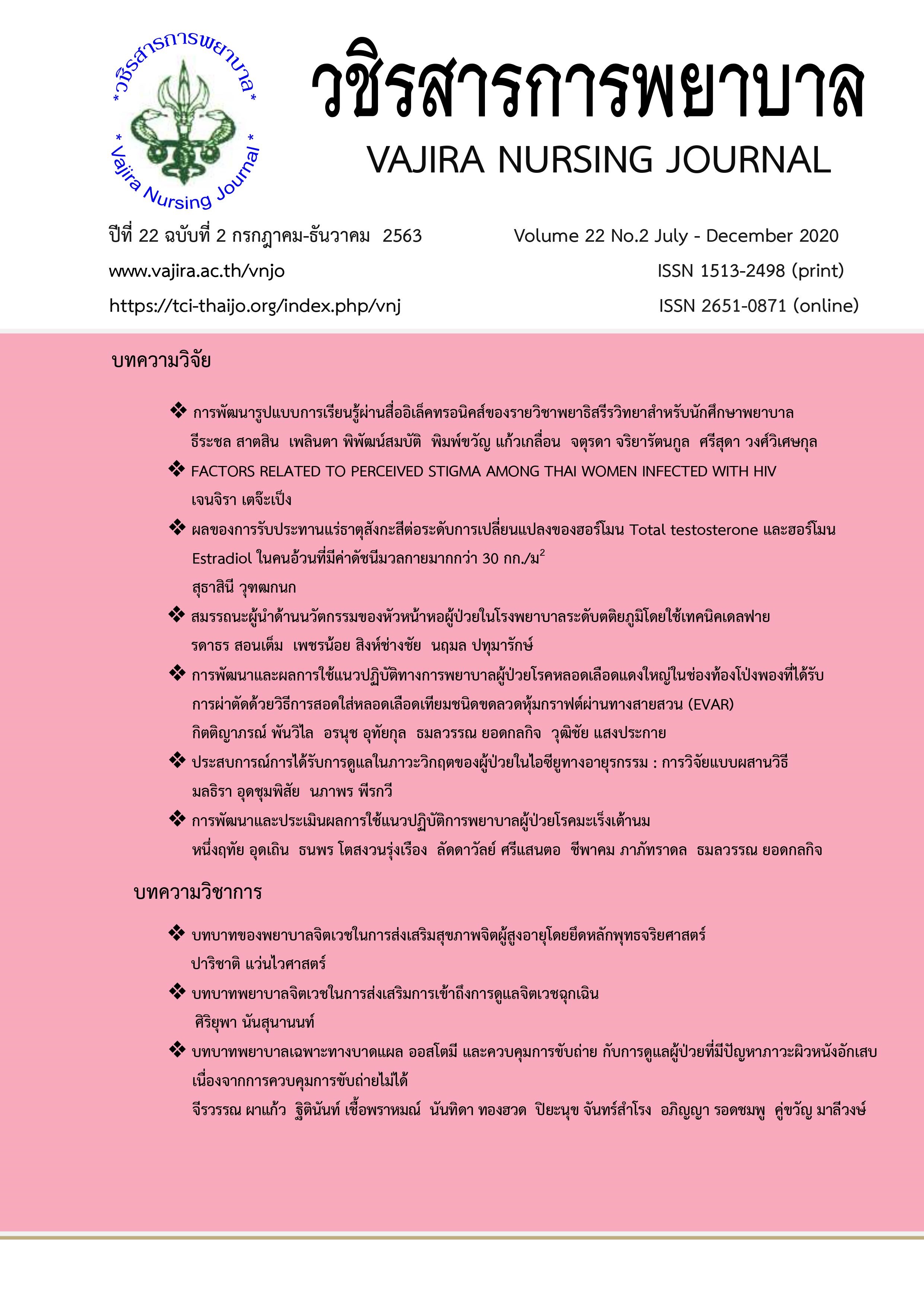ปัจจัยที่มีผลต่อการรับรู้ตราบาปในผู้หญิงไทยที่ติดเชื้อ เอชไอวี
Main Article Content
บทคัดย่อ
การรับรู้ตราบาปในหญิงไทยที่ติดเชื้อเอชไอวีเป็นอุปสรรคในการเข้าถึงการรักษา ซึ่งจะส่งผลต่อความรุนแรงของโรค และคุณภาพชีวิต การวิจัยนี้ เป็นการศึกษาเชิงพรรณามีวัตถุประสงค์เพื่อศึกษาความสัมพันธ์ของปัจจัยที่เกี่ยวข้องกับการรับรู้การตีตราของหญิงไทยที่ติดเชื้อเอชไอวี โดยการหาความสัมพันธ์ระหว่าง ปัจจัยส่วนบุคคล ได้แก่ อายุ ระดับการศึกษา สถานภาพสมรส ระยะเวลาการติดเชื้อเอชไอวี การสนับสนุนทางสังคม และการรับรู้ตราบาป 4 ด้าน ในหญิงไทยที่ติดเชื้อเอชไอวี อายุระหว่าง 18-60 ปี ที่เข้ารับบริการสถานพยาบาลระดับตติยภูมิ เครื่องมือที่ใช้ในการวิจัยพัฒนาตามกรอบแนวคิดของ Berger et al. (2544) และแบบสอบถามการรับรู้ตราบาปของ สุวรรณพร มิตสุวรรณ (2550) วิเคราะห์ข้อมูลสถิติเชิงพรรณา วิเคราะห์ความสัมพันธ์โดยใช้สถิติ t-test และ Chi-square
ผลการศึกษาพบว่า กลุ่มตัวอย่างรับรู้ตราบาประดับปานกลาง ซึ่งสัมพันธ์กับสถานภาพสมรส (p=0.022) อายุ (p=0.01) เมื่อวิเคราะห์การรับรู้ตราบาปรายด้าน สถานภาพรมรสมีความสัมพันธ์กับ personalized stigma aspect (p=0.03) ระยะเวลาได้รับวินิจฉัยติดเชื้อเอชไอวีสัมพันธ์กับ public attitudes aspect (p=0.01), negative self-image aspect (p<0.01) และการสนับสนุนทางสังคมสัมพันธ์กับ disclosure aspect (p=0.002) personalized stigma aspect (p=0.05) และ negative self-image aspect (p<0.003) การค้นพบนี้ชี้ให้เห็นว่าบุคลากรทางการแพทย์ควรจัดกิจกรรมและต้องเข้าใจการรับรู้ตราบาปของผู้ป่วยและปัจจัยที่เกี่ยวข้องเพื่อลดการตีตราผู้ติดเชื้อเอชไอวีในประเทศไทย
Article Details
เนื้อหาและข้อมูลในบทความที่ลงตีพิมพ์ในวชิรสารการพยาบาลถือเป็นข้อคิดเห็นและความรับผิดชอบของผู้เขียนบทความโดยตรง ซึ่งกองบรรณาธิการไม่จำเป็นต้องเห็นด้วย หรือร่วมรับผิดชอบใด ๆ ทั้งสิ้น
บทความ ข้อมูล เนื้อหา รูปภาพ ฯลฯ ที่ได้รับการตีพิมพ์ในวชิรสารการพยาบาล ถือเป็นลิขสิทธิ์ของวชิรสารการพยาบาล หากบุคคลใดหรือหน่วยงานใดต้องการนำทั้งหมดหรือส่วนหนึ่งส่วนใดไปเผยแพร่ต่อหรือเพื่อกระทำการใด ๆ จะต้องได้รับอนุญาตเป็นลายลักอักษรจากวชิรสารการพยาบาลก่อนเท่านั้น
เอกสารอ้างอิง
Berger BE, Ferrans CE, Lashley FR. (2001). Measuring stigma in people with HIV: psychometric assessment of the HIV stigma scale. Research in nursing & health. 24(6):518-29.
Black and Miles. (2002). Perceptions of stress, worry, and support in Black and White mothers of hospitalized, medically fragile infants. Journal of Pediatric Nursing Volume 17, Issue 2, April 2002, Pages 82-88.
Bureau of Epidemiology. (2012). prevalence HIV.
Bussayarin Srikum. (2003). Health Behaviors of Working Patients with HIV/AIDS in a Tertiary Care Hospital.
Erdfelder, Faul and Buchner. (1996). GPOWER: A general power analysis program. Behavior Research Methods, Instruments, & Computers March 1996, Volume 28, Issue 1, pp 1–11.
Ezechi OC, Gab-Okafor C, Onwujekwe DI, Adu RA, Amadi E, Herbertson E. (2009). Intimate partner violence and correlates in pregnant HIV positive Nigerians. Archives of gynecology and obstetrics. 280(5):745-52.
Kiula ES, Damian DJ, Msuya SE. (2013). Predictors of HIV serostatus disclosure to partners among HIV-positive pregnant women in Morogoro, Tanzania. BMC Public Health. 13:433.
Kwanchit Laothong. (2018). Factors Influencing HIV Serostatus Disclosure Among Thai Women. Siriraj Med Bull, 11(1): 2-8.
Mattika Chaichan, Pornnapa Kampraw. (2017). Stigma of HIV: Social Illness. Journal of The Royal Thai Army Nurses. Volume 15 No.3 (Sep - Dec) 2014
Mamen. (2013). Effect of the Low Risk Ankle Rule on the frequency of radiography in children with ankle injuries. CMAJ October 15,185 (15).
Ministry of Public Health Thailand. (2018). Thailand National Operational Plan Accelerating Ending AIDS 2015-2019.
National AID committee. (2016). THAILAND AIDS RESPONSE PROGRESS REPORT.
Poxton IR. (2005). Molecular techniques in the diagnosis and management of infectious diseases: do they have a role in bacteriology? Medical principles and practice: international journal of the Kuwait University, Health Science Centre. 14 Suppl 1:20-6.
Sagay A. S., Musa J., Ekwempu C.O.C., Imade G. E., Babalola A., Daniyan G., et al. (2006). Partner disclosure of HIV status among HIV positive mothers in Northern Nigeria. African Journal of Medicine and Medical Sciences, 35 119-123.
Skinner D & M. (2016). Hepatic TLR2 & TLR4 expression correlates with hepatic inflammation and TNF‐α in HCV & HCV/HIV infection.JVH, V. 18, ISSUE 2.
Social Research Institute. (2017). Reuters Institute Digital News Report 2017.
Stutterheim, S. E., Bos, A. E., Shiripinda, I., de Bruin, M., Pryor, J. B., & Schaalma, H. P. (2007). HIV-related stigma in African and Afro-Caribbean communities in the Netherlands: manifestations, consequences and coping. Psychol Health, 27(4), 395-411. doi: 10.1080/08870446.2011.585426
Supattra Chaipolbal. (2017). Relationships between Selected Factors and HIV Disclosure of Thai Women to Their Partners. Nursing Journal of The Ministry of Public Health. vol 28 No.2
Suwanporn Mitsuwan. (2007). The Relationship between Patience regarding Female Health, Social Support, Stress coping, and Health Status of HIV Infected / female AIDS patients. Master's Degree Thesis in Nursing, Faculty of Graduate Studies, Chulalongkorn University.
Srisamang Songrob. (2008). AIDS in Thai Women. National Review of HIV Early Infant Diagnosis in Thailand
UNAIDS. (2012). Global report: UNAIDS report on the global AIDS epidemic 2010. Geneva, Joint United Nations Programme on HIV/AIDS.
UNAIDS. (2014). The Gap Report 2014 : People Living with HIV Geneva, Joint United Nations Programme on HIV/AIDS.
UNAIDS. (2018). Global report: UNAIDS report on the global AIDS epidemic 2017. Geneva, Joint United Nations Programme on HIV/AIDS.
Van Huy N, Lee HY, Nam YS, Van Tien N, Huong TT, Hoat LN. (2006). Secular trends in HIV knowledge andattitudes among Vietnamese women based on the Multiple Indicator Cluster Surveys.
Weiss. (1970). HIV and AIDS in relation to other pandemics. EMBO Rep. 4:S10-S14.


